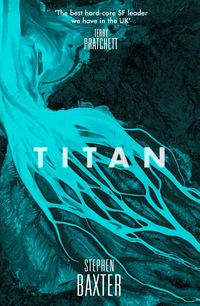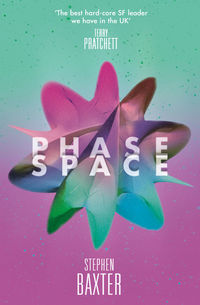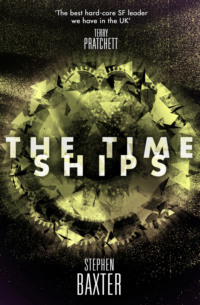
Полная версия
Titan

STEPHEN BAXTER
TITAN
THE NASA TRILOGY


COPYRIGHT
HarperVoyagerAn imprint of
HarperCollinsPublishers Ltd
1 London Bridge Street
London SE1 9GF
www.harpervoyagerbooks.co.uk
First published in Great Britain by HarperVoyager 1997
Copyright © Stephen Baxter 1997
Cover photo © NASA
Cover layout design © HarperCollinsPublishers Ltd 2015
Stephen Baxter asserts the moral right to be identified as the author of this work
A catalogue copy of this book is available from the British Library.
This novel is entirely a work of fiction. The names, characters and incidents portrayed in it are the work of the author’s imagination. Any resemblance to actual persons, living or dead, events or localities is entirely coincidental.
All rights reserved under International and Pan-American Copyright Conventions. By payment of the required fees, you have been granted the nonexclusive, nontransferable right to access and read the text of this e-book on-screen. No part of this text may be reproduced, transmitted, downloaded, decompiled, reverse engineered, or stored in or introduced into any information storage and retrieval system, in any form or by any means, whether electronic or mechanical, now known or hereinafter invented, without the express written permission of HarperCollins e-books.
HarperCollinsPublishers has made every reasonable effort to ensure that any picture content and written content in this ebook has been included or removed in accordance with the contractual and technological constraints in operation at the time of publication.
Source ISBN: 9780006498117
Ebook Edition © June 2012 ISBN: 9780007502066
Version: 2015-10-07
DEDICATION
For Tony, Christine and Catherine
CONTENTS
Cover
Title Page
Copyright
Dedication
Prologue
Book One: Landing
Book Two: Low Earth Orbit
Book Three: Cruise
Day 80
Day 169
Day 325
Day 504
Day 680
Day 1181
Day 2460
Book Four: Ground Truth
Book Five: Extravehicular Activity
Book Six: Titan Summer
Epilogue
Afterword
Keep Reading
Acknowledgements
About the Author
Praise for Stephen Baxter
Also by the Author
About the Publisher
PROLOGUE
After seven years of flight, after travelling a billion miles from Earth, the human spacecraft Cassini reached Saturn.
Cassini was about the size of a school bus. Thick, multi-layer insulation blankets covered most of the craft’s structure and radiation-hardened equipment. The blankets’ outermost layer was translucent amber-coloured Kevlar, with shiny aluminum beneath; the two layers together made it look as if the spacecraft had been sewn into gold.
But Cassini looked its age.
The blankets were yellowed, and showed pits and scars from micrometeorite impacts. The brave red, white and blue flags and logos of the US, NASA, ESA and the contributing European countries, fixed as decals on the insulation, had faded badly in the years since launch. Cassini’s close approach to the sun, with the intense heat and solar wind there, had done most of the damage.
A fat pie-dish shape, ten feet across, clung to the side of the Cassini stack, so that the craft looked like a robot warrior going to battle, clutching a shield. In fact, the shield was a combined aeroshell and heat shield for a separate spacecraft, called Huygens, which was designed to land on Saturn’s largest moon Titan. The results Huygens gathered would serve as ‘ground truth’, confirmation and calibration for the more extensive orbital surveys Cassini would perform of the moon.
Now Cassini reached a point in space almost four million miles from Saturn’s cloud tops.
From here, the planet looked the size of a quarter-inch ball bearing held at arm’s length. Spinning in just ten hours, the planet was visibly flattened. A telescope might have shown its yellowish cloud tops, with their streaky shading and complex, anti-cyclonally rotating cloud systems. The sun was off to the right, with its close cluster of inner planets, so Saturn, seen from the probe, was half in shadow. The ring system, tight around the planet, was almost edge-on to the spacecraft, all but invisible, and it cast sharp shadows on the cloud tops.
Titan – the largest of the moons, orbiting twenty Saturn radii from its parent – was a reddish-orange pinprick, well outside the ring system.
Titan appeared to lie directly ahead of the spacecraft.
It was time.
Pyrotechnic bolts fired, silently, releasing puffs of vapour that immediately crystallized and dispersed. Three springs pushed Huygens away from Cassini, and a curved track and roller made the released probe spin, at seven revolutions per minute.
The path of Huygens and its parent probe diverged, at half a mile per hour.
Two days after the release, with the two craft about thirty miles apart – each clearly visible from the other, as a bright, complex star – Cassini fired its main engine once more, to deflect its orbit. Now Cassini and Huygens parted more rapidly.
Cassini’s nominal mission was a four-year orbital tour of the Saturn system. Its objectives were to study Saturn’s atmosphere, the atmosphere and surface of Titan, the smaller icy satellites, the rings, and the structure and physical dynamics of the magnetosphere.
And while Cassini flew on, Huygens – dormant, unpowered, a mere ten feet across, spinning slowly for stability – fell directly towards the burnt-orange face of Titan.
It was November 6, 2004.
… It would be a second-generation star.
It formed from a spinning cloud, of primordial hydrogen and helium, polluted by silicon, carbon and oxygen: rock and snow, manufactured by the first stars, the oldest in the Universe.
The cloud was a hundred times the width of the Solar System, to which it would give birth.
The cloud collapsed, and spun faster. It heated up. At last, the cloud became unstable, and broke up into successively smaller fragments.
It shrank. The cloud became opaque, and the heat it generated as it collapsed could no longer escape.
The core imploded suddenly.
The collapse made the core, a protostar, shine brilliantly, ten thousand times as bright as the sun that would shine on mankind.
Eventually the core was so hot that hydrogen nuclei began to fuse to helium. The thermonuclear energy generated balanced the inward gravitational force. The protostar stopped contracting.
It was a star. The sun.
The remaining nebula cloud condensed into dust particles and snowflakes. The orbiting particles collided with each other, and – because of the stickiness of the ice, and the organic tars coating the dust – they formed a flat disc of swarming planetesimals, objects ranging in size from a few yards across to several miles.
The planetesimals collided; some grew in size, forming planets, and others fragmented.
Most of the nebula’s mass was lost in the process.
Earth formed in a million years. Earth was dominated by rock, its snow boiled away by the young sun’s heat, its surface pounded by planetesimals.
Further out, it was different.
Further out, everything was moving more slowly, and the nebula was less dense. It was cold enough for water, carbon dioxide, ammonia and methane to condense into ice. So while the inner planets were dominated by rock, the accreting planetesimals at Jupiter’s orbit and beyond swept up dirty snow.
Hundreds of millions of years after Earth, Saturn formed, gigantic, gaseous. It radiated heat as it collapsed, warming the orbiting fragments of nebula gas and dust.
Around Saturn, an accretion disc formed. Moons coalesced, from a mixture of water ice, silicates, ammonia, methane and other trace elements.
One of them was massive.
It was half rock, half ice. It heated as it collapsed, because of its huge mass; the primordial ices melted and vaporized. The rock settled to the center, because of its greater density. At last, at the core of the moon, a ball of silicate formed, overlaid by a shell of ice, six hundred miles thick.
An ocean gathered. It was a mixture of ammonia and methane. A dense atmosphere was raised over it. The new world was a cauldron, with pressures hundreds of times that of Earth’s sea level in human times, and temperatures measured in hundreds of degrees.
The high pressure and temperature were sustained, for millions of years. And in the organic soup of the ammonia-water ocean, complex chemistry seethed.
But the new ocean and atmosphere were not stable. Ultra-violet flux from the young sun beat down; planetesimals continued to fall, blasting away swathes of the air; the atmospheric gases dissolved in the ocean.
The atmosphere cooled and thinned. The pressure dropped.
The ocean froze over.
New methane lakes formed, which converted slowly to ethane. Sunlight broke up atmospheric ammonia, to release a new atmosphere of nitrogen.
The moon settled into its long freeze.
But it was not inert. Ultraviolet photons from the sun and charged particles trapped in Saturn’s magnetic field beat down on the thick layer of air. Chemistry continued in the new atmosphere, and complex organic deposits rained down on the frozen surface …
Thus, for billions of years, Titan waited.
An object looking a little like a comet streaked across the sky of Titan, battering atmospheric gases to a plasma twice as hot as the surface of the sun itself.
Cooling, it fell towards the surface slush.
A parachute blossomed above it.
Huygens was built like a shellfish, with a tough outer cover shielding a softer kernel, with its fragile load of instrumentation. When its job was done, the outer aeroshell broke open, like the two halves of a clam shell, and the main chute unfolded.
So, after being carried across a billion miles, the aeroshell was discarded. It had absorbed nearly a third of the probe’s entire mass.
The descent module, exposed, was built around a disc-shaped platform of thick aluminum. Experiments and probe systems were bolted to the platform. The equipment was shrouded by a shell of aluminum, with a spherical cap for a nose and a truncated cone for a tail. It looked something like an inverted clam. Now cutouts in the shell opened, and booms unfolded from the main body. Instruments peered through the cutouts, or were held mounted on the booms, away from the main body.
Tentatively, the lander sought contact with the orbiter.
Fifteen minutes after its unpackaging, the main chute was cut away, and a smaller stabilizer chute opened.
The probe began to fall faster, into the deep ocean of air. Vanes around its rim made it rotate in the thickening air.
Diaphragms slid back. A series of small portals opened in the protective shell of the craft, and sensors peered out.
At the base of Titan’s stratosphere, some thirty miles above the surface, the temperature began to rise a little. Gradually, the surface became visible. Downward-pointing imagers peered, in visible and infra-red light, and as the probe slowly rotated, mosaic panoramas were built up.
At last, the probe crashed into the slush. Slowed by Titan’s low surface gravity, and the density of the lower air – half as dense again as Earth’s – the impact was slow, as gentle as an apple falling from a tree.
The probe continued its battery of experiments, pumping telemetry up to the orbiter, which sailed onwards towards Saturn.
Huygens was primarily an atmospheric probe. It had not been certain that the probe would survive the impact. And the probe had actually been designed to float if need be, for none of its mission planners had been sure whether oceans or lakes existed here, or if they did how extensive they were, or whether the chosen landing site would be covered by liquid or not.
Just six minutes after landing, the probe’s internal batteries were exhausted.
Melted slush frosted over the buried portals of the inert, cooling lander. And a thin rain of light brown organic material began to settle on the upper casing.
The chatter of telemetry to Cassini fell silent. The orbiter passed beneath the horizon, and then turned its high gain antenna away from Titan, to Earth. Patiently, Cassini began to download everything the lander had observed.
Some of the results were unexpected.
Paula Benacerraf worked through her EVA suit checklist.
She connected her Snoopy hat comms carrier to the suit’s umbilical. She set the sliding oxygen control on her chest pack to PRESS. She put on her gloves and snapped home the connecting rings. Then she lifted her helmet over her head. The suit built up to an overpressure, and she tested it for leaks.
The ritual of checks was oddly comforting. It took her mind off what she was about to do.
Tom Lamb rapped on her backpack.
Paula Benacerraf turned, awkwardly. Foot restraints held them both in standing positions, packed in head-to-toe. In her EMU – her suit, her EVA mobility unit – she felt ludicrously bulky, awkward in the confines of Columbia’s airlock, which was just a cramped, cylindrical chamber in the orbiter’s mid deck.
‘That’s it, Paula. I think we’re go.’
She said, ‘Already?’
‘Already.’ Lamb grinned out of his helmet at her, and she could see silvery stubble in the creases of his leathery cheeks. ‘You’re an independent spacecraft now.’
Her heart was hammering under the tough surface of her HUT, her hard upper torso unit. ‘Spaceship Paula. It feels good.’
Tom Lamb had once been the youngest Moonwalker. Now, at sixty-two, he was one of the oldest humans to have flown in space.
And Benacerraf, forty-five, a grandmother, was one of the oldest rookies.
Benacerraf disconnected her suit from the wall mount.
Lamb said, ‘Houston, we’ve got the hatch closed and we’re waiting for a go for depress on time.’ His native Iowan twang was overlaid with a Texan drawl acquired over long years at Houston.
‘Affirmative, EV1; you have a go for depress.’
Lamb turned to the control panel and turned the depress switch to position 5. Then, with the pressure down to five psi, Lamb turned the switch to its second position. ‘Depress valve to zero.’
Benacerraf heard a distant hiss. She moved the oxygen control on her chest pack to its EVA position.
‘Pressure down to point two,’ Lamb said now. ‘Let’s motor.’ He kicked his feet out of their restraints. With a confident motion he twisted the handle of the outer airlock hatch. Benacerraf thought the hinges and handle looked old, like bits of a school bus, with the polish of long use.
Lamb pushed the hatch outward, and Paula Benacerraf gazed into space.
She was looking along the length of the orbiter’s payload bay. The big bay doors were gaping open, the silvered Teflon surfaces of their radiator panels gleaming, and the bay itself was a complex trench, crammed with equipment, stretching sixty feet ahead of her. There was no direct sunlight; the bay was in the shadow of a wing, and the light in the bay was like a diffuse daylight.
Tom Lamb moved out through the airlock’s round hatchway, and drifted over to the left payload bay door hinge. There was a handrail and two slide wires that ran the length of the big hinge, and Lamb tethered himself to the wires. She could see his bright EV1 armbands.
He turned and waited for her.
‘Houston, the hatch is open and EV1 is out.’
‘We see you, Tom.’
‘EV2 is halfway out, getting ready.’
Benacerraf, with her hands on the doorway, felt as if she was frozen in place, as if she really couldn’t step out there.
Lamb lifted up his big gold visor, so she could see his face. ‘Just stay with it, kid. One step at a time.’
She grunted. ‘Some kid,’ she said.
Somehow, though, Lamb’s gravelly words punctured her tension.
She kept her eyes down on the floor of the payload bay and drifted through the hatch, just as she had done a hundred times in training, in the big swimming pool in the Sonny Carter Facility at Ellington Field. She fixed her own tether in place. Now, at least, she wouldn’t go drifting off into space.
For the first time she looked up.
Columbia was flying with her instrument-laden payload bay pointing at Earth, so that the planet was a ceiling of light above Benacerraf, a belly of ocean strewn with white, shadowed clouds.
Earth flooded the orbiter with light.
When he saw she was tethered, Lamb pulled himself along the length of the payload bay with practised ease. He reached the far end, and, diminished, he performed a simple pirouette, his tether flailing around him slowly.
‘Hey, Paula,’ Lamb said now. ‘Look at your hands.’
She lifted up a gloved hand before her face. There was grease on the glove, from the payload bay door hinge.
When she’d first joined the astronaut corps six years ago Benacerraf had been in complete awe of Tom Lamb.
He was the last Apollo veteran still working in the program, all of thirty-two years since the last Lunar Module had lifted off that remote surface. Tom Lamb still called himself an aviator, Navy style. She knew he had some kind of antique aeronautics degree from some technology institute in Georgia. But as far as he was concerned, Lamb was primarily a graduate of the Naval Pilot Test School at Patuxent River, in Maryland. She knew he had been known as a superb stick-and-rudder man, and his specialism had been night carrier landings, the hairiest flying in the Navy.
And as a young teenager Paula Benacerraf had watched Lamb and his commander Marcus White bounce like sun-drenched beach balls over the rubble-strewn floor of Copernicus.
How could you meet, how could you work with, a man like that?
But the awe had soon worn off, for Benacerraf.
Benacerraf was an engineering specialist – her discipline was orbital construction techniques – and she’d come into NASA with a hatful of qualifications, awards and degrees. She’d worked as a ground-based contractor on a number of Space Station construction missions. It was only when, because of Shuttle launch wave-offs and Russian construction delays, the Station assembly sequence had started to fall drastically behind its timeline that the need had been identified to draft the right experience directly into the program.
So – against the advice of her daughter Jackie, against the resistance of her employers – Benacerraf had given up her fancy consultant’s salary and her nice apartment in Seattle, and moved down to the humid stink of Houston, on Government pay.
At first she’d worked as a specialist in the backrooms behind the Mission Control rooms, in Building 30 of JSC, the Johnson Space Center. Then she’d been promoted to work as a Mission Controller, in the FCR – the Flight Control Room – itself.
But it still wasn’t enough. It was pretty obvious that this construction project – if it was ever going to get back on schedule – needed foremen in space.
Benacerraf had been a space nut since watching Lamb and his buddies on the Moon, all those years ago. But the thought of actually going up there herself, in a dinged-up old Space Shuttle, pretty much appalled her.
Tom Lamb himself had been deputed to talk her round. He’d used all the grizzled charm at his disposal.
… But I’ve got two grandchildren, Tom.
Hell, so have I. And if I can still cut it, a couple of years off my pension, why not you?
She was given promises of cooperation, special provisions, fast-tracks through the training. Even bonuses, to compensate her for her dropped salary. You’ll be treated with respect, drawled Tom Lamb. We need you, kid.
The training maybe hadn’t been quite as smooth as she’d been led to believe – too much resistance from the Spaceflight Training Division for that, who had insisted she had to work her way through their hierarchy of trainers and simulators, fast-track or no fast-track. But the pumped-up pay had come in as promised.
She just hadn’t bargained for the respect.
As an ascan, an astronaut candidate, she was royalty – at the rank of princess, at any rate, until she flew. People around the JSC campus were truthfully in awe of her, and the deference with which she was suddenly treated embarrassed her deeply.
But if she was a princess, Tom Lamb was a king among kings. And he loved it. She would watch him stroll through the Public Affairs Office or the clinic or the Crew Systems Lab, and people come running to serve him. And Lamb just lapped it up. It was as if Lamb had spent the whole of his adult life preparing for this role. Which, in a sense, he had.
Her opinion about Tom Lamb had evolved rapidly.
She pulled herself tentatively along the slide wire.
The orbiter was like a splayed-open aircraft. Before her she could see the big delta wings, spreading out to either side of the payload bay. Straight ahead, at the far end of the bay, was the bulky, rounded propulsion system housing, with its tanks and the engine bells for the main engines and the orbital manoeuvring system. Behind her was the flat rear bulkhead of the cabin section, like the wall of a big roomy shack, which contained the rest of the crew.
The curve of the wings was elegant. But for her, the design was spoiled by the softscreen mission sponsors’ logos displayed there: the US Alliance, Boeing, Lockheed, Disney-Coke. She knew that stuff brought in a lot of money to NASA, but for her it was a step too far.
At the back of the bay she could see the EDO wafer, the extended-duration pallet with its supplement of lox and liquid hydrogen for the orbiter’s fuel cells, which would allow Columbia to stretch out this mission to sixteen days. One objective of this flight had been to test the new EDO wafer in extremes of temperature, so the orbiter had been aligned to keep the payload bay in shadow for hours at a time, longer periods than on most flights.
Tom Lamb approached her, along the starboard fuselage longerons. ‘You ready for the MMU?’
‘Sure.’
‘Houston, EV2 preparing to deploy MMU.’
‘Copy that, Tom.’
Benacerraf made her way to the MMU station. The Manned Manoeuvring Unit was a big backpack shaped like the back and arms of an armchair. Since launch it had been stored in its station in the payload bay against the rear cabin bulkhead, on the starboard side.
Lamb had got there first, and he ran a quick check of the MMU’s systems.
‘You ready?’
‘Let’s do it.’
Lamb held her arms. He turned her around, and she backed into the MMU. She felt latches clasp her suit’s backpack.
‘Houston, EV2,’ she said. ‘EMU latches closed.’
‘Copy that.’
She pulled the MMU’s arms out around her. She closed her gloved hands around the controllers, which were simple hand-controllers on the end of the arms. A fibre optic data cable plugged into her suit from the MMU.










